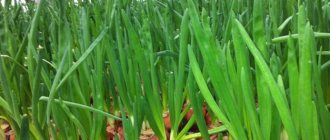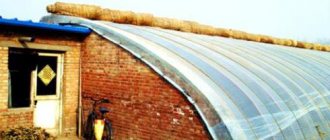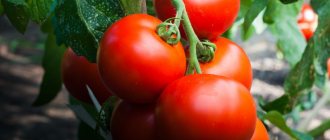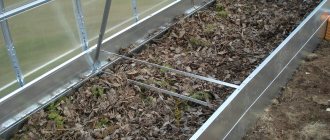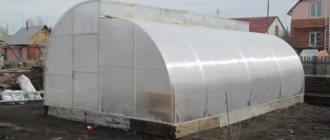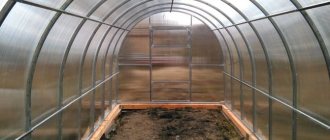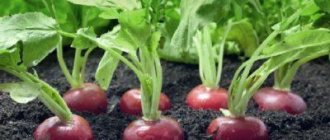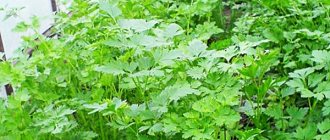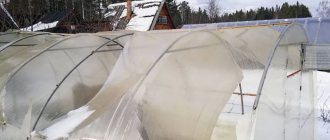A large or small greenhouse structure installed on a site is rightfully considered a reliable friend and assistant for gardeners and gardeners, allowing them to independently grow high-quality vegetable seedlings at a time when nature has not yet fully woken up after winter. The riot of young green leaves located behind the greenhouse wall promises the worker a bountiful harvest, financial support, joy and pleasure from the pleasure received when growing and harvesting large vegetable fruits. To realize a dream, you need to make a lot of effort and then your plans will definitely come true.
If in winter your greenhouse installed on your personal plot was “resting”, no work was carried out there, then at the end of winter or beginning of spring, you need to begin large-scale preparations for the new season. How to prepare a greenhouse structure, what needs to be done first? Let's figure it out.
Clearing snow from all buildings and surrounding areas
Let’s say that your greenhouse, that is, its frame, spent the winter without shelter - this means that snow drifts can occur both on the territory of the structure and around it. Snow and ice are a kind of “refrigerator” that keep the soil frozen and prevent the sun’s rays from warming it up. It is necessary to remove snow piles at a distance of about two meters around the greenhouse walls. There is no need for snow indoors anymore. The soil, cleared of snow, is covered along the outer perimeter of the greenhouse structure with dark roofing material, which is well warmed up by the sun's rays and saturates the already covered greenhouse with warm air. Remember, the greenhouse soil will thaw much faster, and you can begin the next stage of preparatory work.
If the greenhouse is of good quality and resembles a residential building in appearance, then there will be no snow inside, but it also needs to be removed around the building. They also clear the snow cover from the roof, since the melting snowball becomes very heavy and can damage the roof, so it is best to remove it in time. For detailed recommendations and rules for removing snow from structures, read this article. The garden paths leading to the greenhouse are also cleared of snow.
April
In greenhouses, sowing of cucumbers for seedlings for greenhouses, insulated and open ground continues (at the end of the month). Continue caring for growing plants. Harvesting, green crops are sown.
Cucumber seedlings are planted in film shelters and greenhouses for subsequent planting in open ground.
As the soil is freed from snow, it is loosened to retain moisture. Fertilizers are applied. They make beds for sowing peas, beans, beans, parsley, radishes, lettuce, onions, carrots, and other crops. After sowing, to protect against birds, a net is pulled over the beds. With the emergence of shoots it is removed.
If the grown seedlings of early white cabbage and cauliflower have 5-6 leaves and have been hardened, then they can be planted in open ground in late April - early May.
“Sanitary” repairs as necessary
It is much more difficult to repair and replace parts that have failed. Repair work also depends on the type of structure, quality of materials used and how long ago it was built.
- Film greenhouse. The simplest and most economical option, often used in dachas and gardens located far from home, is a film greenhouse. Such structures are moved from place to place, changing shape and size. After inspecting the film shelter that has been overwintered on the frame, damage is identified and, if possible, the film is repaired or replaced, in whole or in part. If old polyethylene is used for covering, then both the inside and outside of the film are washed with a solution of laundry soap. Thus, they remove dirt, facilitate the penetration of sunlight through the film walls and warm up the greenhouse soil. If the film covering is replaced with a new one, then only the accessible parts of the frame are washed, and then the polyethylene is stretched. Due to the fact that a film greenhouse is a non-durable structure, portable and without a permanent frame and foundation, serious repairs will be required. Wooden supports can rot, become loose and even break due to gusts of wind or the weight of snow. It is necessary to replace broken wooden parts with new ones. Metal frames are affected by corrosion. Parts of the building with deep rust marks require replacement. Damaged and bent parts of the grille are supplemented with new ones that enhance the strength of the structure.
- Polycarbonate or glass greenhouses. Such structures are stronger, more reliable and durable. But, upon inspection, it is still possible to detect minor damage and eliminate them in time. Remember, cracked glass and bent polycarbonate require replacement, not risky use for another season. The resulting cracks must be sealed with a special material.
August
Fruitful cucumber plants are removed from the greenhouses, taken out and burned. At the beginning of the month, they finish sowing head lettuce for seedlings.
Tomato care continues in heated greenhouses. On the best bushes, several fruits are left for harvesting seeds. Greenhouses are being prepared for the autumn-winter season.
In open ground, fruiting of cucumbers is prolonged by laying out loops, adding soil and watering.
Continue pinching the tomatoes and pinching their tops after forming 4-5 clusters on them. Late brushes are removed. When late blight appears, the bushes are destroyed. Start harvesting your own tomato seeds.
Onion sets, turnips, and garlic are removed if the above-ground part dies off. Hill up leafy and winter cauliflower. Causes feather lodging on onions. For pumpkins, no more than 2-3 fruits are left on each vine.
Cellars, basements, and other storage areas are disinfected and ventilated.
Spicy herbs are dried for winter use, cucumbers and tomatoes are salted and pickled.
Creating greenhouse heating
After cleaning and repairing the greenhouse structure, it is necessary to ensure high-quality heating, because the spring sun shines, but does not warm much, and the plants need warmth. Each owner has his own way of creating a warm atmosphere in a greenhouse.
Methods for creating heating in a greenhouse
There are many variations that will help heat the greenhouse, these are:
- Using a stove-stove. The ancient ancient method of heating a room is still relevant in our time. A potbelly stove with an iron water container installed on top is placed in the greenhouse itself and is periodically heated with wood, coal or dry spruce branches, maintaining heat inside the room.
- The north wall covered with black material inside the greenhouse can serve as a natural catalyst for warm air and an economical method of retaining heat.
- The dug up soil of the greenhouse is also covered with a dark film, which accumulates and retains heat. When sowing seeds, cross-shaped holes are made in the covering and sown in them. Future roots are kept warm, and weeds do not germinate well.
- Greenhouse soil, in high frosts, turns into dust, dries out greatly, does not thaw and warm up well. After creating a warm atmosphere in the room and at least partial warming of the earth, the greenhouse soil is dug up and trenches are made between the beds for better access of warm air to the ground and warming up the soil.
- Use of electricity. Of course, the method is not cheap, but it is effective. Fireplaces and fan heaters installed around the perimeter of the greenhouse structure will help warm the soil and walls of the greenhouse.
General recommendations for preparing a greenhouse for winter and the new season
In general, everything is described above about how to treat a greenhouse in the fall and prepare it for winter, but I would like to note a few more features and rules for caring for the structure in the autumn-winter period:
- It is necessary to treat not only the greenhouse and the soil with fungicides, but also the tools that are used in it (secateurs, rake, shovel, hoe, saw, etc.). After all, if they are not disinfected, they can become a source of infection. After processing, you need to move them to a dry, closed room.
- If the reliability of the frame does not inspire confidence, then at the end of autumn you can strengthen the frame so that it does not collapse under the weight of snow. The easiest way is to place wooden or metal supports inside the structure.
- Also, if the structure does not seem reliable, then in case of heavy rainfall it is recommended to remove snow from the roof surface.
- In winter, the door to the greenhouse must be closed so that wind and bad weather do not damage the structure. However, if the manufacturer of the building recommends leaving the door open for the winter, then it is better to follow this advice (but again, if your region has very frosty winters and strong, cold winds, then it is better to open only the window and securely fix it).
- At the end of winter or early spring, it is recommended to throw snow into the greenhouse so that the soil is saturated with melt water. Bringing snow earlier is not recommended, because the ground covered with warm snow is more favorable for wintering pests. In addition, soil without snow freezes better, which is very good for preventing pests and diseases.
Autumn is a time of intensive preparation for winter and caring for the garden after harvest. We should not ignore greenhouse structures and greenhouses, because they help us get a good and tasty harvest of vegetables. Also, don’t put it off until spring; it’s much more efficient to do everything in the fall. Besides, there is so much to do in the spring, so you will spend your time and energy rationally.
Soil preparation
Work to prepare the soil for sowing seeds is also carried out in several stages, which are mandatory.
- Cleaning. The maximum accumulation of spores of fungal diseases is in the top layer of soil, so experienced gardeners recommend removing the top layer of soil about five centimeters deep. Cover the vacated areas with rotted manure mixed with mineral fertilizers.
- Screening. The soil in the racks must be sifted through a garden sieve to remove the roots of sprouted weeds and fluff up the soil mixture.
- Replacement of soil. To obtain a high-quality root system and branched leaf crown of seedlings, it is necessary to monitor the fertility and condition of the soil. Breeders involved in developing new varieties of vegetable crops recommend replacing the top layer of the soil mixture every season with a new one that has not previously been used in a greenhouse, but preferably purchased in a specialized store. The technology is simple - you need to remove the top layer of soil, 15-20 centimeters, and fill the formed voids with purchased soil or prepare a new soil mixture yourself, fertilizing it. To prepare the soil, mix garden soil, washed sand, peat and humus. To neutralize the acidic environment, add up to three kilograms of slaked lime per cubic meter of soil.
- Disinfection. A mandatory and useful procedure for spring preparation of a greenhouse is disinfection of the entire structure and soil mixture.
There are several ways to carry out disinfection
- Treatment with chlorine solution. 450 grams of bleach are dissolved in a bucket of water and the soil and walls of the greenhouse are sprayed with this solution. A bleach solution will disinfect surfaces and destroy spider mites.
- Using a solution of iron sulfate. Wooden frames can become a breeding ground for mosses and lichens. The affected areas are first scraped to remove the lichen, and then treated with a solution of 5% iron sulfate.
- The use of slaked lime and copper sulfate. Three kilograms of slaked lime powder are mixed with 500 grams of copper sulfate and poured with ten liters of warm water. Remember, this solution is suitable for treating and disinfecting polycarbonate and glass walls, ceilings and frames.
- Treatment with biological products. Treatment with biological preparations such as Fitosporin or Fitop-Flora-S will completely destroy spores of fungal bacteria and pathogens, improve the microflora and are completely safe for the growth of green crops.
February
In greenhouses where cucumbers are grown, high air humidity is maintained by watering the passages, under the shelves and heating pipes. Flowers are pollinated by hand or with the help of bees. They enrich the atmosphere of the greenhouse with carbon dioxide, for which they install shallow dishes with diluted mullein or bird droppings. Feed the plants. The first harvest of cucumbers begins.
Seedlings are sown with tomatoes (for spring greenhouses), cucumbers (for heated greenhouses), celery, peppers, eggplants, cabbage, and lettuce.
Manure for a greenhouse is placed in a pile so that it does not warm up prematurely.
Snow retention is carried out in the garden.
Organic and mineral fertilizers are imported and stored in the required quantities. Glaciers are installed for short-term storage of seedlings and freshly harvested green crops.
Inspect vegetables and potatoes stored for storage.
Work that began in January continues.
Cultivation and improvement of soil fertility
Land beds in greenhouse buildings are constantly and fully used. Having examined the entire area of the greenhouse, you may not find any free space or unused area. The soil gives up all its reserves to the future plant, increases the green mass and root system. If work is not done to cultivate the greenhouse soil, fertilize it and enrich it with nutrients, then soon the greenhouse structure will completely cease to exist and perform its special function of growing, first of all, early seedlings of vegetable crops. To improve greenhouse soil, you can do the following:
- Sawdust from deciduous trees. Small and light sawdust will loosen the soil well and prevent it from caking and clumping. Mix sawdust and superphosphate and apply to the soil in the greenhouse bed.
- Vermiculite or perlite particles. You can dilute and improve the structure of greenhouse soil by adding vermiculite, which loosens the soil mixture, retains moisture and nutrition added using liquid fertilizer. The roots of the plant will receive moisture and additional nutrients. Remember, pathogenic bacteria do not live on vermiculite granules, so feel free to use it in practice. Perlite has no nutritional element, but is still necessary in greenhouse soil. Particles of the substance contribute to the capillary distribution of water flows along the plant stem, preventing the soil from clumping and caking.
- Humus. The most useful and accessible organic fertilizer for all gardeners, produced by living organisms, will qualitatively improve the soil layer of the greenhouse, increase fertility, and saturate the soil with useful nutrients.
- Organic fertilizers. Rotted chicken droppings and cow manure, two-year-old compost added to the soil will enrich the soil with nitrogen and phosphorus, magnesium and boron, calcium and potassium, various minerals, micro and macroelements.
- EM drugs. “Siyanie 2”, “Vostok Em-1” will saturate the greenhouse soil with beneficial microorganisms that can disinfect the soil, suppress pathogenic and putrefactive microflora, and improve the soil structure.
Timely and high-quality preparation of the greenhouse in the spring guarantees early vegetable production. A large harvest, an abundance of nutritious fruits and financial enrichment can be brought to a conscientious owner by a greenhouse structure with light, loose soil, equipped with beneficial microflora and nutritious organic matter, well prepared for growing vegetables.
Join our Facebook group
Green manure to help
Not everyone knows that cucumbers are capable of releasing toxic substances - colins. The source of infection is the root system. Colins are dangerous only for the cucumbers themselves and their relatives.
Green manure plants will help neutralize toxins. Immediately after harvesting the last harvest (approximately in September), scatter mustard or oilseed radish seeds on the beds.
After 1 month, dig up the beds. This procedure will help enrich the soil with useful substances and destroy colitis.
A clean and healthy greenhouse is the key to a large harvest. Therefore, autumn preventive work does not require delay, especially since other concerns will begin in the spring.
Treat with copper sulfate
Cleaning using a solution of copper sulfate disinfects walls and other surfaces from larvae and eggs of pests, fungal infections (late blight, scab, powdery mildew).
The procedure involves wiping the walls with a sponge and spraying the solution onto hard-to-reach surfaces. The prepared solution is used to clean various greenhouses - wooden ones with glass or film, or made of polycarbonate.
Necessary ingredients for the solution: water, copper sulfate powder, quicklime. A mixture of copper sulfate powder (100 g) and lime (150 g) is dissolved in a 10-liter bucket of water.
In the greenhouse, use a rag or sponge soaked in a solution to wipe the internal walls, frames, supports, and if there are shelves. It is recommended to spray the solution from a spray bottle on wooden surfaces or in hard-to-reach corners.
There is no need to rinse off the composition. At the end of the procedure, the structure is closed overnight and then ventilated.
Recent Entries
Lilac perennials that are beautiful, compact and do not crowd out other plants Why when buying seedlings you should not take the sellers’ word for it and how to determine the age of the plant using 3 signs Tomato seedlings have turned purple or whitish: why the color has changed and how to save the plants

